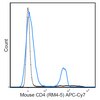ABN2287-100UG Sigma-AldrichAnti-Dystrophin
Anti-Dystrophin, Cat. No. ABN2287, is a rabbit polyclonal antibody that detects Dystrophin and is tested for use in Western Blotting, ELISA and Immunohistochemistry.
More>> Anti-Dystrophin, Cat. No. ABN2287, is a rabbit polyclonal antibody that detects Dystrophin and is tested for use in Western Blotting, ELISA and Immunohistochemistry. Less<<Recommended Products
Overview
| Replacement Information |
|---|
| References |
|---|
| Product Information | |
|---|---|
| Format | Purified |
| Presentation | Purified rabbit polyclonal antibody in PBS with 0.1% BSA with 0.05% sodium azide. |
| Quality Level | MQ200 |
| Physicochemical Information |
|---|
| Dimensions |
|---|
| Materials Information |
|---|
| Toxicological Information |
|---|
| Safety Information according to GHS |
|---|
| Safety Information |
|---|
| Storage and Shipping Information | |
|---|---|
| Storage Conditions | Recommended storage: +2°C to +8°C. |
| Packaging Information | |
|---|---|
| Material Size | 100 μg |
| Transport Information |
|---|
| Supplemental Information |
|---|
| Specifications |
|---|
| Global Trade Item Number | |
|---|---|
| Catalogue Number | GTIN |
| ABN2287-100UG | 04065272074216 |
Documentation
Anti-Dystrophin SDS
| Title |
|---|
Anti-Dystrophin Certificates of Analysis
| Title | Lot Number |
|---|---|
| Anti-Dystrophin - Q4177684 | Q4177684 |















